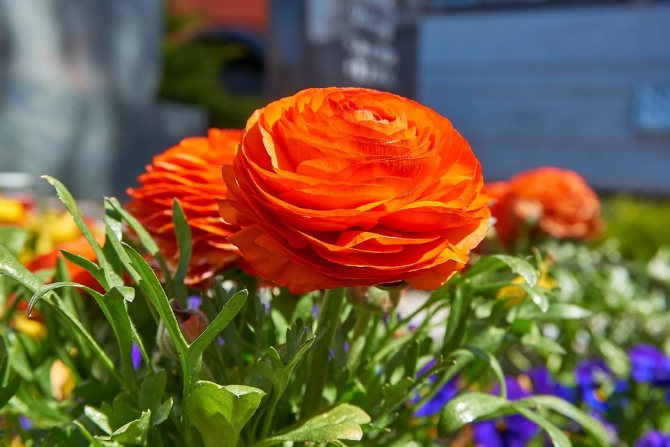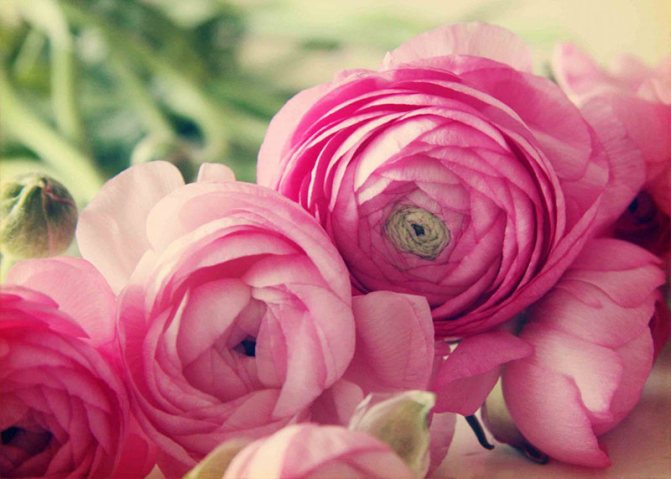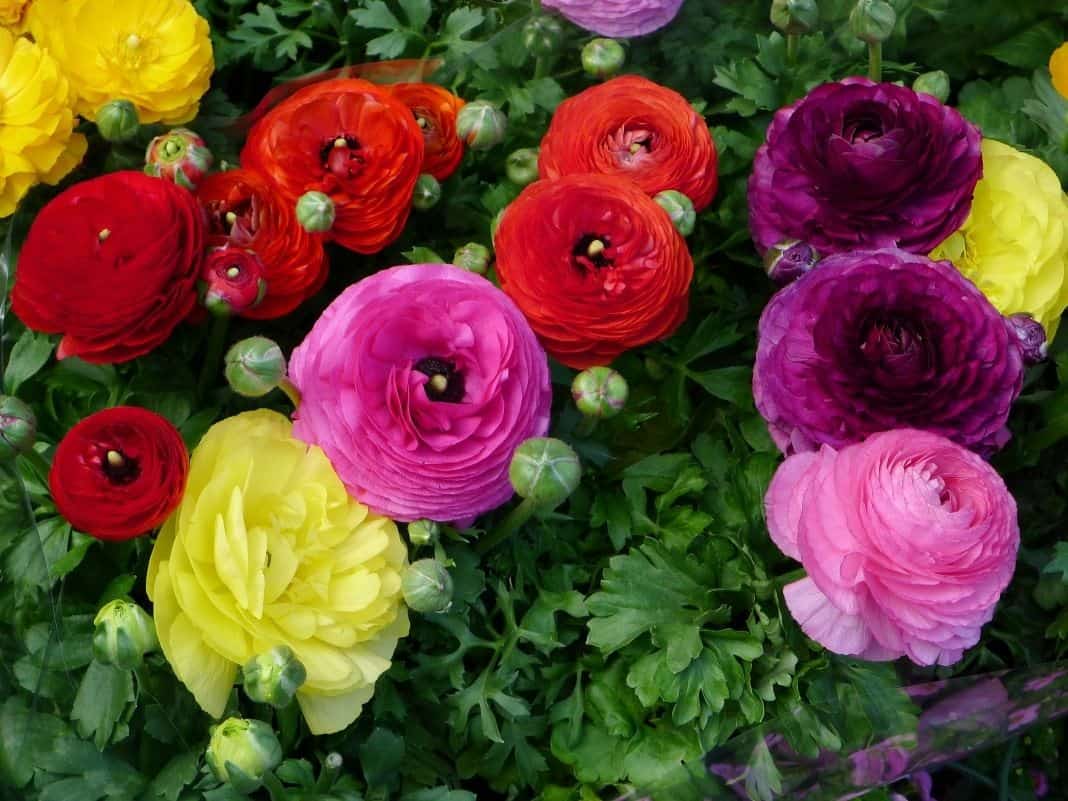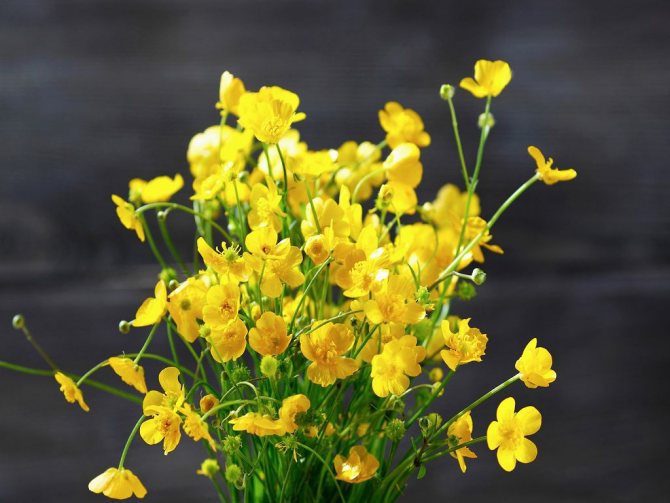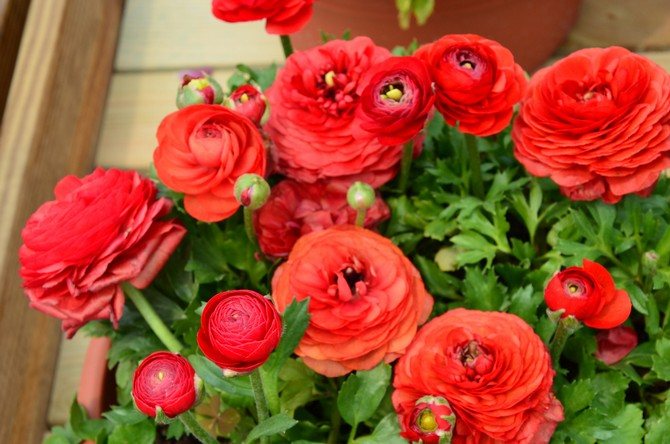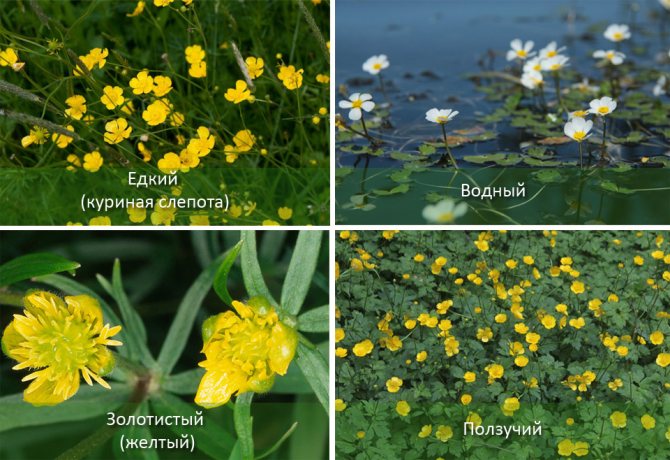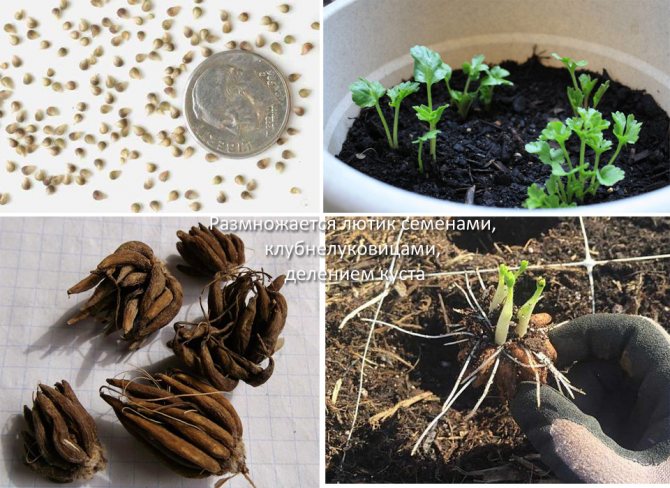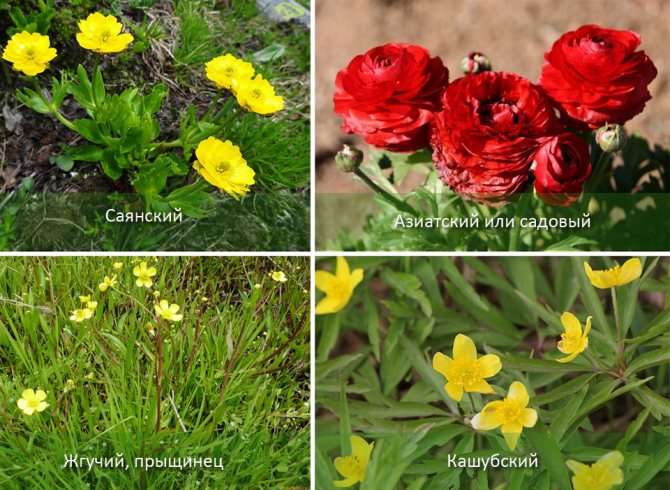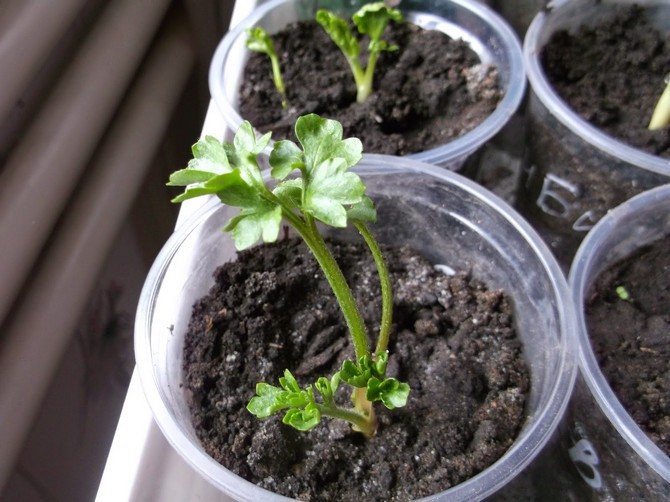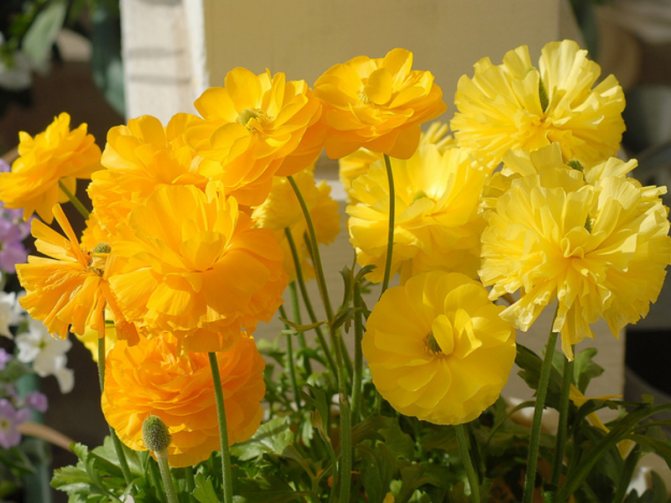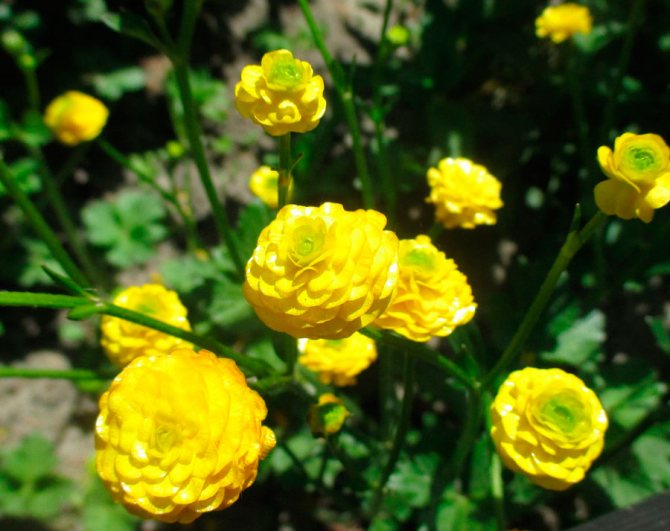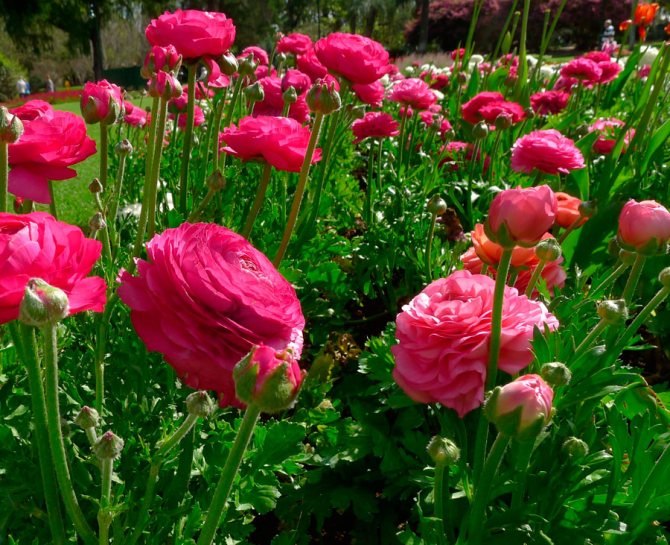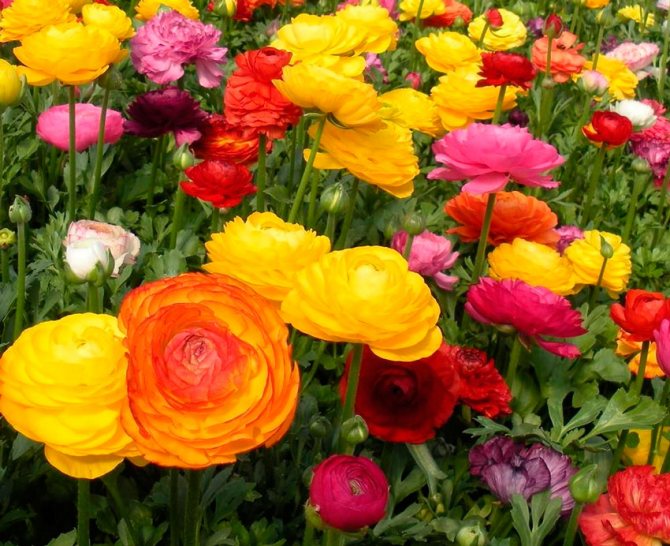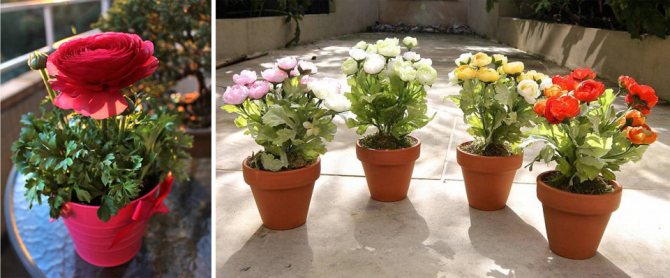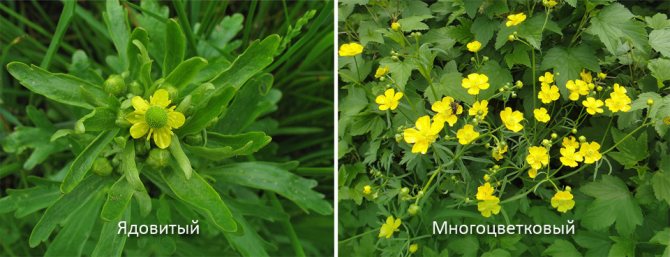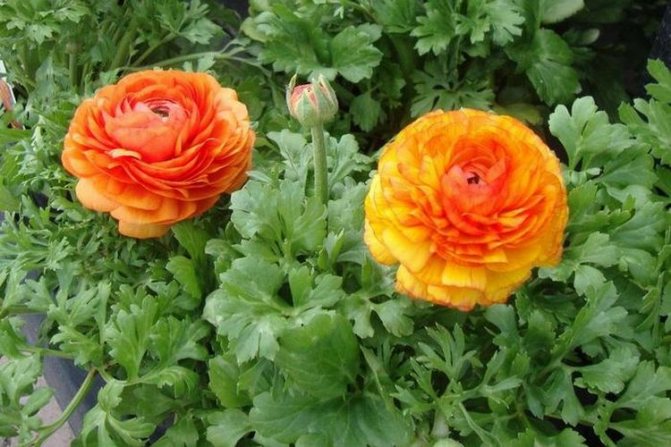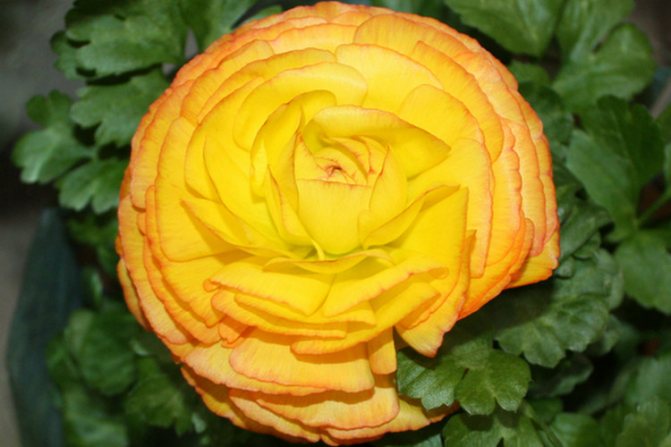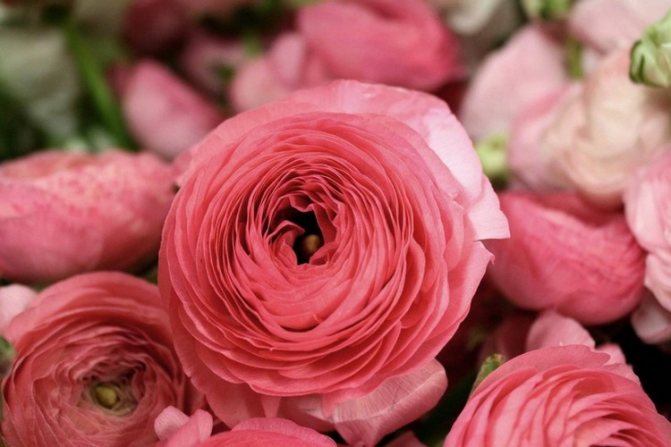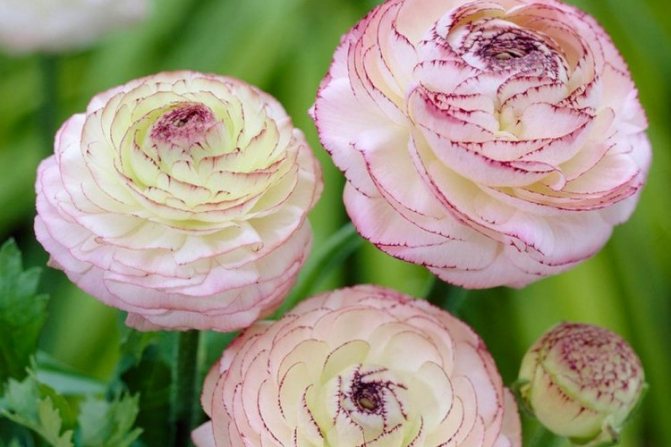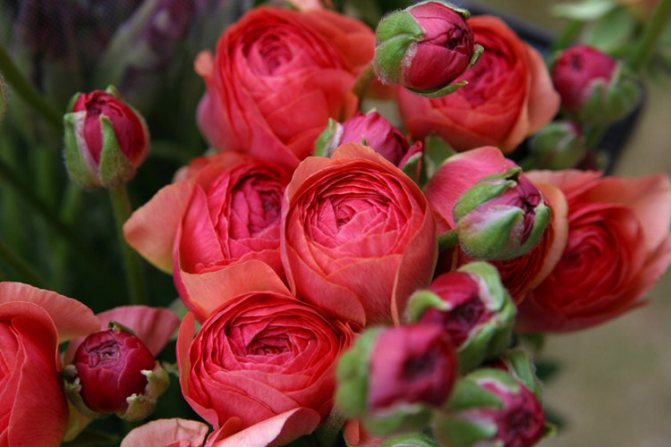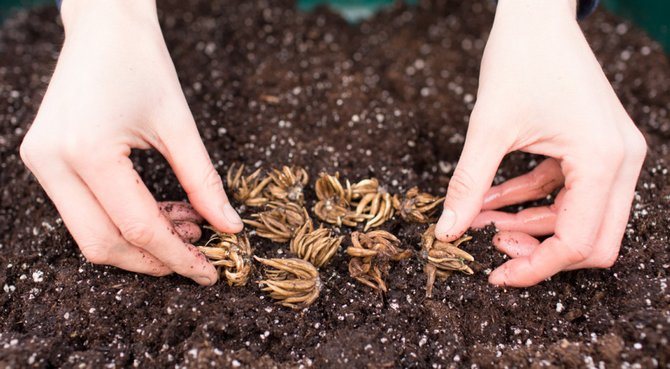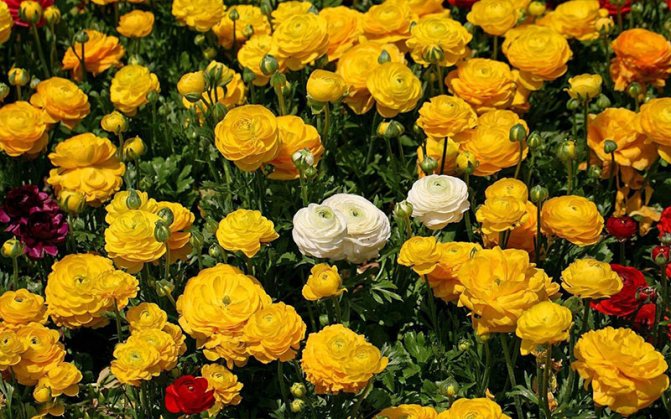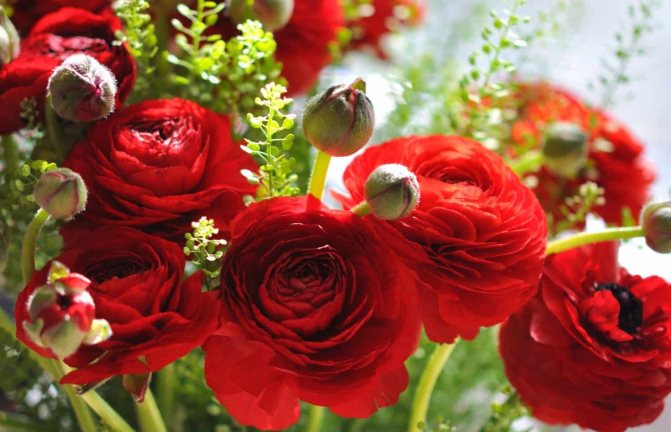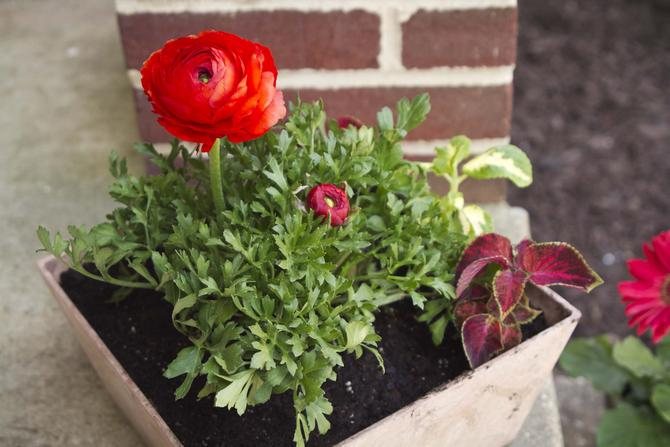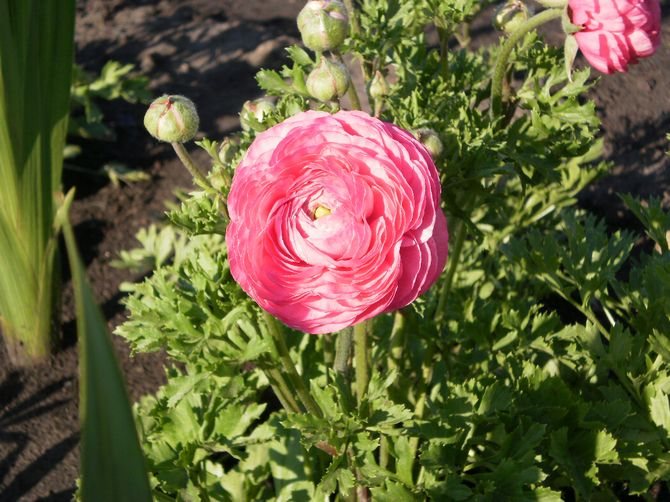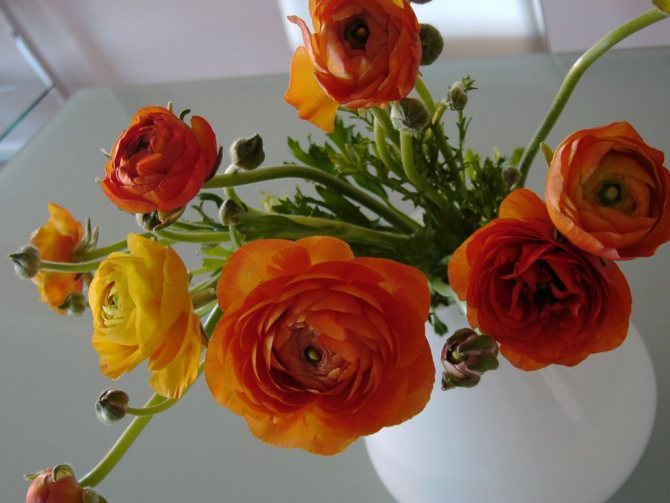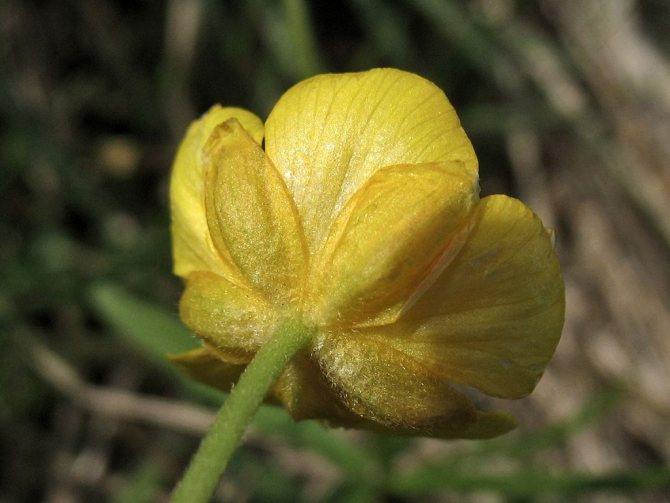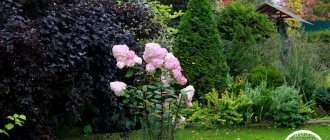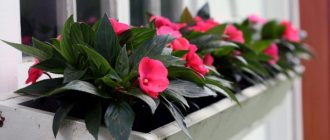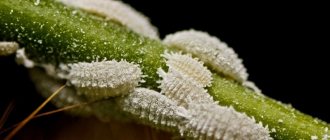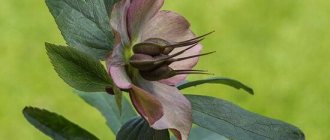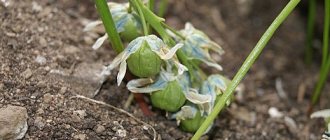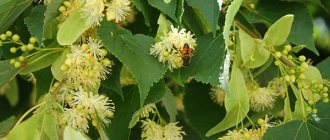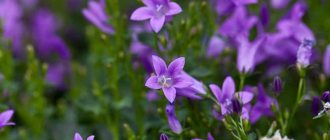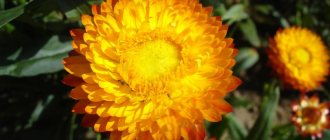The garden buttercup looks like small roses. Their second name is Ranunculus from the Latin word "frog". The plant bears this name because of the proximity of growing areas to water bodies. Bright decorative varieties are of particular beauty. In the wild, the flowers are medium-sized and have a yellow tint. Caring for such a flower is simple, but it is worth knowing a number of subtleties before planting it.
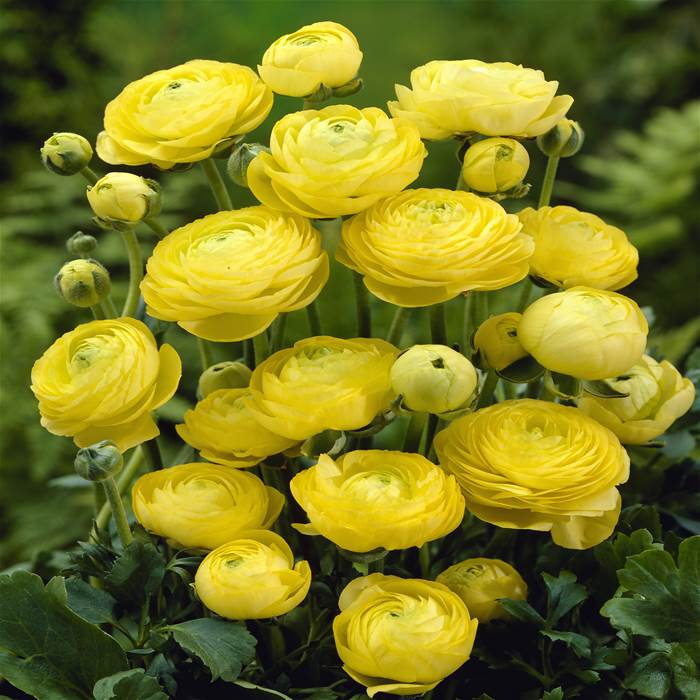
A little about the garden buttercup family
It is a perennial belonging to the buttercup family. It is poisonous, in natural conditions it grows near lakes, rivers, ponds or in the water itself. In nature, there are more than three hundred species that grow in the northern regions. For breeding for decorative purposes, gardeners usually use garden buttercups. Flowering lasts about a month.
If before buttercups were considered a common weed, then after the labor of breeders, the result was large flowers, similar to a miniature rose or resembling a peony. They began to breed it in the 16th century, and after a hundred years this plant has become no less popular than the tulip.
Plant height reaches 65 centimeters, and its stem is branched with trifoliate leaves. The approximate size of a garden buttercup flower is from 8 to 10 centimeters. The shades of the buds are bright. They can be salmon, yellow, red, blue, etc. Bicolor varieties of buttercup have also been bred. A plucked flower stands for a long time in a bouquet or in a composition. It does not fade for about a week. Despite its beauty and desire to touch, one should not touch the plant because of the poisonous sap, it is necessary to protect children and animals from contact.
Landing place
The place for the garden buttercup should be protected from wind and sun. The garden buttercup flower is not too picky about the composition of the soil. It is best if the substrate is with a drainage layer, nutritious and slightly moistened. Flowers are planted when the frost on the soil ends and the weather reaches a stable plus.
If the soil is flooded with rain and properly, not dry or cold, then the seedlings will quickly die. In regions where ground frosts are often observed, experienced gardeners recommend planting flowers in peat pots. On warm days, the buttercup can be placed on the loggia or balcony. Do this if the weather outside is at least 15 degrees Celsius. When the ground warms up, you can plant the seedlings in a permanent place.
Popular: Planting perennial lychnis for landscape design
At home, a container with a plant is placed on the south window. It can be placed on the east or west side. If there is not enough light, then it is necessary to supplement the flower with an artificial lamp. Buttercup is watered infrequently and only with settled water at room temperature.
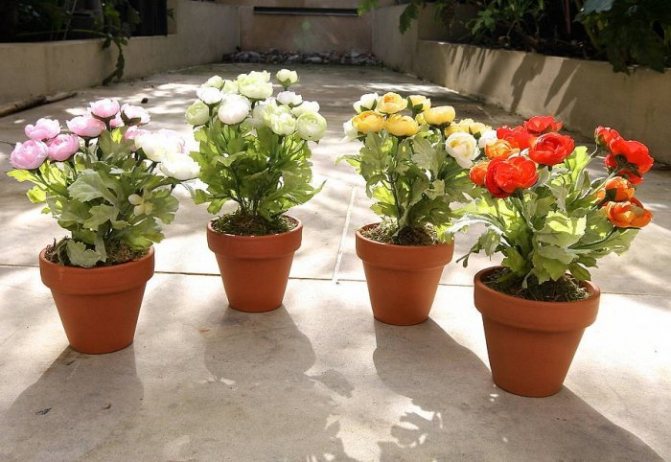

Popular species and varieties
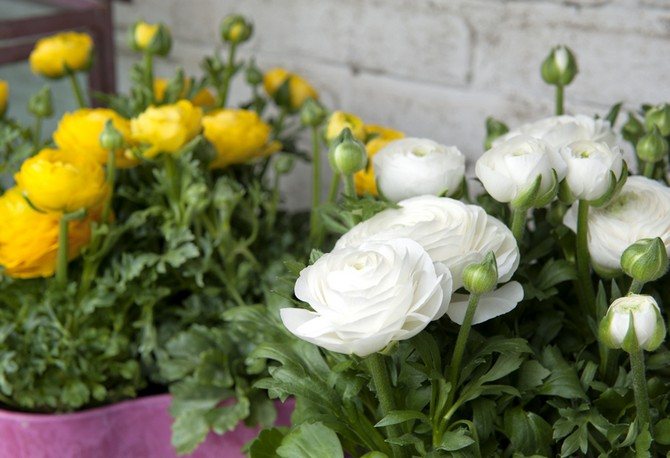

- Asiatic buttercup - this variety is distinguished by its beautiful double flowers, which are very similar to roses. The shrub reaches about forty centimeters in height.
- African buttercup - this variety is very similar to a peony. Its distinctive features are flower petals, which are, as it were, wrapped inward and bright green leaves of large size.
- Pungent buttercup - This species is often found in the wild, prefers moist meadow or forest soils and partial shade areas.The plant is frost-resistant and has medicinal properties. Active flowering begins in early summer, the flowers are golden yellow in color.
- Aconitol buttercup - this species is distinguished by flowering white or yellow. The shrub reaches a height of almost 80 centimeters.
- Anemoliferous buttercup - This is a low-growing bush plant (no more than 30 centimeters in height).
- Multi-flowered buttercup - This perennial type of shrub blooms throughout the summer, medium in height (about half a meter), blooms with shiny yellow flowers.
Garden buttercups retain their decorative properties for 3-4 years, after which it is advisable to update the varieties.
Planting process: propagation by rhizome
Before planting, you should carefully examine the tuber. High-quality planting material is not damaged by fungus or mold. It is not brittle and a little thick. There is no mechanical damage on it. It is best to store tubers by folding them in paper bags. Large tubers can be divided into multiple roots.
Planting buttercups involves the preparation of planting material. Root cones should be soaked in water with the addition of growth biostimulants. After soaking, the bumps become large. They should not be buried more than five centimeters in the soil. In this case, they are laid with the roots down. The gap between seedlings should not be less than ten centimeters. After that, the soil is watered, but a little so that the roots do not start to rot.
You can buy such tubers in a store or on the Internet. The garden buttercup is a thermophilic plant, the roots of which are dug up and stored. The tubers can be stored in peat pots or wrapped in cloth. The temperature in the storage room should be at least 17 degrees. Plants are stored in September when the rhizome dries up. During this period, it is pulled out of the ground and dried.
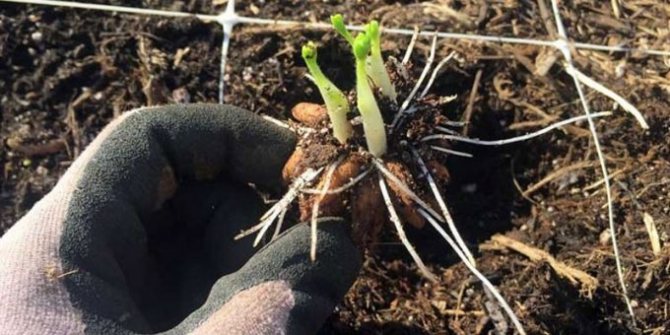

Seed propagation
In the spring, the buttercup in the garden can be sown with seeds. To do this, prepare a container for planting with sand. From above, the container is closed with glass so that there is a mini-greenhouse mode here. Ventilation is necessary from time to time.
After the first shoots appear, the buttercup is transferred to a sunny warm place. A buttercup should be planted in an open bed only when at least three leaves appear on the seedling. Seeds do not germinate well, and if the planting material was stored incorrectly, then it may not germinate at all. Buttercup seedlings should be well looked after, ventilated on time and kept to a watering regime.
The seeds planted do not always correspond to the color on the label. In the process of growth, the buttercup can lose its decorative qualities. The planted bush will not bloom in the first year, but only in the second. When buying planting material, you need to pay attention to the procurement date. The best growing varieties are marked with the F1 brand.
Popular: Three Properties of Perennial Persian Chamomile Feverfew
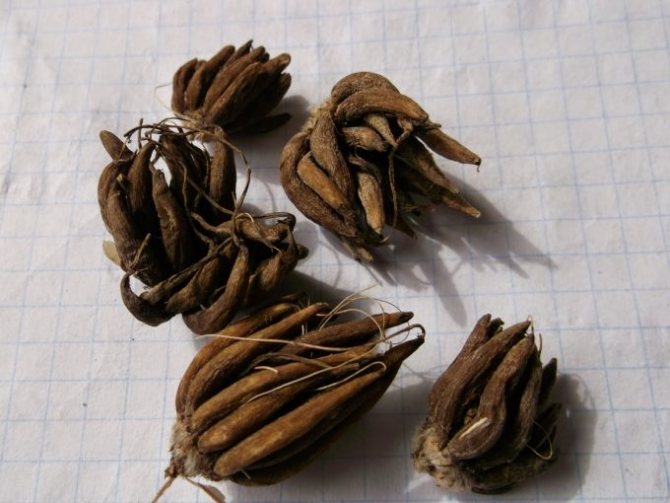

Planting in open ground
Holes are dug on the breast (flowerbed) at intervals of 20 centimeters. A drainage layer is poured into it. Then the seedling is placed on top. Transfer is carried out together with a lump of earth. The soil is poured into the hole, then the earth is compacted and watered.
Buttercup seedlings and other types of buttercups do not bloom immediately in the first year after planting. But in the second season, flowers appear on the plants. It is important that the plant does not grow and stifle other flowers with its presence.
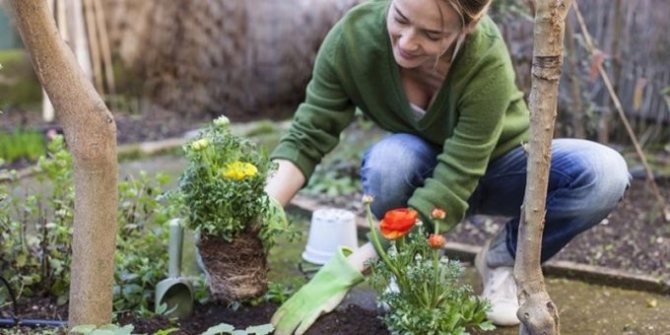

Priming
Neutral soil or slightly acidic soil is suitable for this flower. In this case, the substrate should be nutritious and light.
Watering mode
The roots of the plant do not like when they are poured, but they also react sharply to dryness. In this regard, the buttercup should be watered correctly so that the soil moisture is optimal. The soil should be touched with your hands to make sure it is not dry or flooded.
With a dry substrate, the flower is watered.So that there is no stagnation of moisture, a drainage layer of expanded clay or pebble stones is made at the bottom of the hole. When flowering ends, water the buttercup less. Watering should not be frequent and abundant. The plant, when flooded, begins to rot and dies.
Growing from seeds
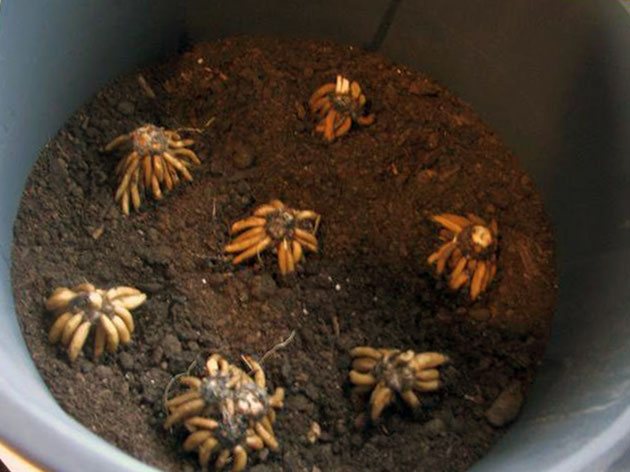

Garden buttercups are grown from seeds or propagated by tubers. Experienced gardeners advise buying seeds in flower shops. The fact is that self-collected seed material has a low germination rate. And collecting seed from such a plant is not at all easy.
This flower is grown through seedlings. Seed material is sown at the end of the winter period or the beginning of the spring. Fill the box with a light, loose soil mixture made up of sand, leafy and peaty soil (1: 2: 2). Spread the seeds evenly over the surface of the substrate, and then sprinkle them on top with a thin layer of earth. Moisten crops with a sprayer.
The seedling box should be covered with foil or glass on top, after which it is removed to a cool place (from 10 to 12 degrees). Do not forget to arrange regular ventilation, and also remove condensation that appears on the surface of the shelter. The first seedlings should appear 15–20 days after sowing. As soon as this happens, transfer the crops to a well-lit and warm (about 20 degrees) place. A southern window sill is perfect for this, only crops should be shaded from direct sunlight. Be prepared, if necessary, to provide additional lighting for the plants.
When 4 or 5 true leaves are formed in the plants, they are subjected to a pick. For this, peat-humus pots are used.
How to fertilize a buttercup
If you want a flower to grow healthy and delight longer with its beautiful flowers, it must be fertilized. Usually gardeners use nitrogen-rich formulations as top dressing.
As buds form, the soil should be enriched with fertilizers containing phosphorus and potassium. Fertilize the soil every 14 days. This is enough for the buttercup to bloom for a long time, and the growth is active.
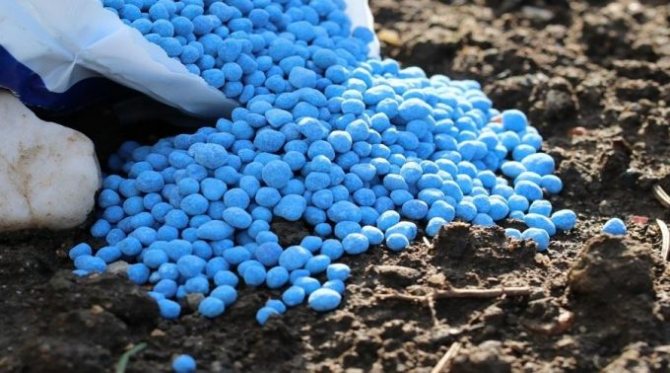

Storage of tubers (wintering)
At the end of the flowering of buttercups, the frequency of watering is reduced, and with the yellowing of the leaves, it completely stops. The plant does not tolerate sub-zero temperatures (it dies at -7 ° C), therefore, it is dug up in August-September. It is important to carry out the procedure immediately after the foliage dies off, otherwise the flower may give young shoots, which is highly undesirable.
After digging, the tubers are washed, examined for pests and diseases. Cleaning from the ground is done carefully so as not to damage the thin roots.
Preparing for winter
Buttercup is not the most hardy plant. If climatic conditions allow, then it is enough to cover the bush with spruce branches or dry leaves. You can additionally insulate the flower in winter by throwing snow on it.
Popular: Maintenance and care of perennial heather aster
In a harsh winter, gardeners recommend digging up the rhizomes and storing them at home. The flower does not tolerate such manipulations. The plant may grow weaker the next year. If the climatic conditions are harsh, then the option is to buy new planting material, for example, the Kashubian buttercup variety.
Possible threats
Diseases and pests:
- nematodes. Rhizomes are affected and exist at the expense of living plant juices, breed under conditions of excessive watering in summer heat. Difficult development of ranunculus, foliage twisting are noted. Plants are dug out of the ground, the rhizomes are cleaned of soil residues - they can be distinguished by rounded lesion zones. The roots are immersed in a bucket of hot water for five minutes, but not warmer than fifty degrees. The contaminated soil is subjected to antiparasitic treatment, the plant is dug in again.An alternative is a five-day treatment of ranunculi with "Mercaptophos", three times in a daily interval;
- spider mite. There are yellowish or ash-colored spots on the leaf plates on top, and whitish specks on the underside. Damaged foliage must be removed, the plant is subjected to insecticidal treatment;
- mold rot. It develops in conditions of excessive watering or unreliable drainage, when the liquid is retained in the near-root zone of the soil. A whitish bloom is noted on the leaf blades, the buds dry out. To eliminate the disease, the leaves are cut with a pruner, the cuts are moistened with a fungicide solution. The soil is loosened, the volume of irrigation is reduced;
- aphid. There are spots, damage on the leaves. Affected leaf plates are pruned, the plants are sprayed with an insecticidal preparation such as "Biotlin".
Activities related to digging up a flower threaten with unpredictable consequences. The viability of the Asiatic buttercup weakens during transplantation and manipulation of tubers during the active life cycle.
Before the flowering period, preventive treatment of ranunculus is organized, for spraying water is used with dissolved caustic soda in a half-percent con, diluted in a ratio of seventy-eighty grams per ten-liter bucket.
The Asian buttercup is an adornment of the garden economy and an aid in decorating and drawing up picturesque bouquets. Elementary floriculture skills and the correct organization of the site are required to grow ranunculus in flower beds. Tuberous planting of these flowers gives the fastest and most impressive results.
What is sick of a garden flower
Such ornamental plants are practically not affected by diseases. But if the summer is too wet, then powdery mildew may appear on it. Less commonly, the bush is affected by the cabbage butterfly or nematodes.
When infected with nematodes, the flower does not grow well, its leaves curl. The gardener should pull the bush out of the ground, remove the soil from the roots and rinse them in warm water. Its temperature should be no more than 55 degrees. Treatment with insecticidal agents helps from the rest of the insects.
Diseases and pests
Basically, all diseases of the garden buttercup arise from improper care. The most common reason is too waterlogged soil. From this, the roots begin to rot, flower buds fall off and powdery mildew appears.
In the fight against powdery mildew, various insecticidal solutions and aerosols will help. So that water does not stagnate in the soil, it is necessary to take care of drainage during planting and do not forget about loosening the soil. Sometimes the usual drying of the soil can save a wilting plant.
Excessive watering is indicated by the appearance of mold on the leafy part of the plant. In this case, you need to completely abandon watering for a while. The soil will dry out a little, and the flower will again delight with its flowering.
The most common pests in the garden buttercup are spider mites and nematodes.
Signs of a mite are spots on the leaves (silvery or yellow). In this case, urgent treatment with special drugs is needed.
Signs of the appearance of a nematode are leaves curling into tubes, slow growth of the plant. The roots of such plants urgently need manganese treatment. It is enough to rinse the roots of the plant extracted from the ground in a pink solution and the pest will die.
Application
In order for a flower to develop quickly and begin to bloom, it needs sun, and slight shading is also possible. Many landscape designers love buttercup for its decorativeness and willingly compose compositions with them. The combination of buttercup and arabis or daisy looks spectacular. Growing side by side, these plants complement each other. Next to the Arabis, he will receive the desired shade and nutrients.
You can plant these flowers next to a small tree or shrub.But if it is decided to use buttercups only for cutting, then you need to plant them separately on the flower bed. They are often used to decorate flower beds, rose gardens, alpine slides. Plants are often planted in pots or containers. And also they are used at special events and photo shoots because of its appearance.
Now read:
- Varieties, planting and care of perennial rudbeckia
- Hanging flower art with ampelous plants
- A persistent, large harvest of cucumbers after planting for seedlings
- Delicate, easy-care coniferous bushes in garden plots
About
Agronomist of the state agricultural enterprise "Garovskoye" of the Khabarovsk region of the Khabarovsk region.


